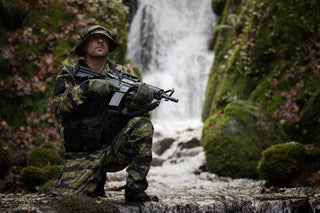Tigerstripe: The Story Behind an Icon
April 30th, 1975. The Vietnam War ends, marking the close of a two-decade conflict, a key period in military history. Among its many legacies—helicopters thundering through jungle canopies, the rise of special operations, and televised combat—one quietly endures in fabric form: Striking in appearance and respected for its jungle effectiveness, Tigerstripe camouflage.
From French Roots to Vietnamese Stripes
Although Tigerstripe is most famously associated with elite US units like the SEALs and Green Berets, its story began long before American forces set foot in Vietnam. Its origins trace back to the French colonial era. During their occupation of Vietnam, the French military introduced their "lizard" camouflage—a series of horizontal, brushstroke-like patterns.

When the French withdrew in 1954, the newly established Vietnamese Marines began developing their own spin on this style. Known locally as Sọc Răn (literally, "Striped Uniform"), these patterns evolved into what we now recognize as Tigerstripe: black horizontal stripes outlined in tan, overlaid with irregular brown strokes on a green field.
From Advisors to Operators: The American Adoption
As US advisors began working closely with the Army of the Republic of Vietnam (ARVN), many adopted the local Tigerstripe uniforms. They weren't just better suited for jungle warfare—they also helped American personnel blend in with their Vietnamese counterparts.

However, as the conflict escalated from advisory roles to full-on combat, Tigerstripe became a standard wear for US Special Forces in-country. While units like the SEALs and Green Berets were eager to embrace the pattern, they faced a problem: standard ARVN uniforms didn't fit the larger frames of American troops.
Made to Measure: Local Production and Global Influence
Early on, custom uniforms were made by local tailors. Soon after, unit-level orders were placed with manufacturers in Thailand, Korea, and Japan. This patchwork supply chain gave rise to various Tigerstripe styles, each with its own quirks. Some of the better-known variants include:
- Tadpole
- John Wayne
- Gold Tigerstripe (also known as Advisor Pattern)

From Vietnam to the World
Tigerstripe eventually began to fade from US use as the war wound down, and the ERDL camouflage was introduced, which later evolved into the M81 Woodland pattern.
Popularity Endured
But Tigerstripe never truly disappeared.

Many countries adopted their own versions, and the US maintained a love-hate relationship with the pattern. It resurfaced in training use with the 75th Rangers, appeared as a grey digital camo for the US Air Force, and was even spotted on CIA operators wearing Desert Tigerstripe during operations in the Middle East during the GWOT.
Tigerstripe Reborn: A New Drop from Arktis
Today, Tigerstripe stands as one of the most iconic and enduring camouflage patterns in military history. At Arktis, we're proud to be part of that legacy.
We've partnered with Tiger Stripe Products to bring this storied pattern into a new era—with both heritage styles and modern interpretations. Whether you're a collector, a camo aficionado, or just appreciate good design, you won't want to miss this drop.
🟢 Available Now on our webstore —just in time to mark the anniversary of the pattern's rise to fame.



